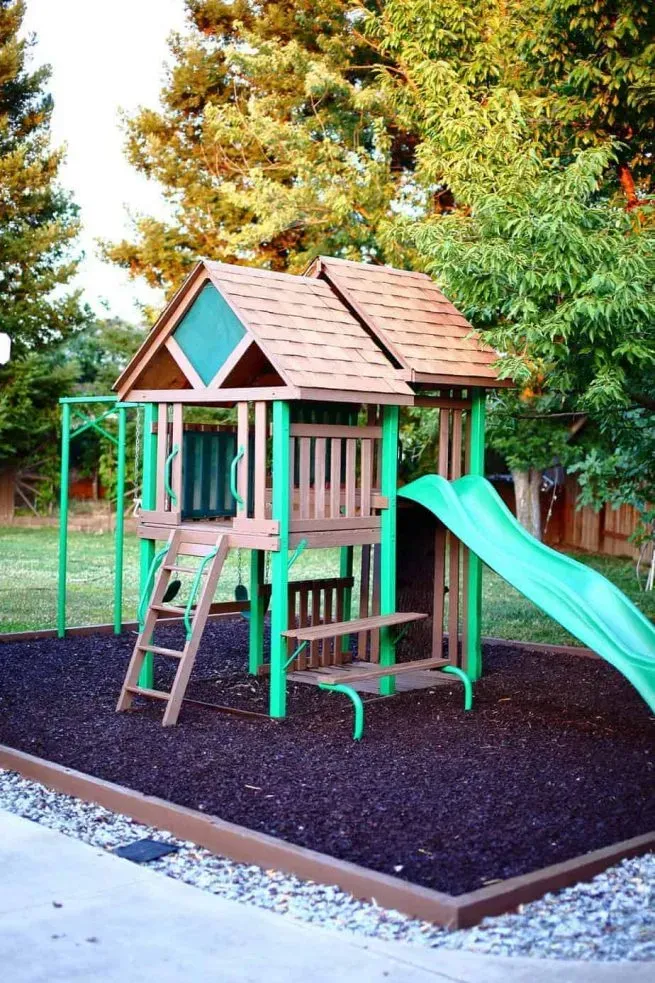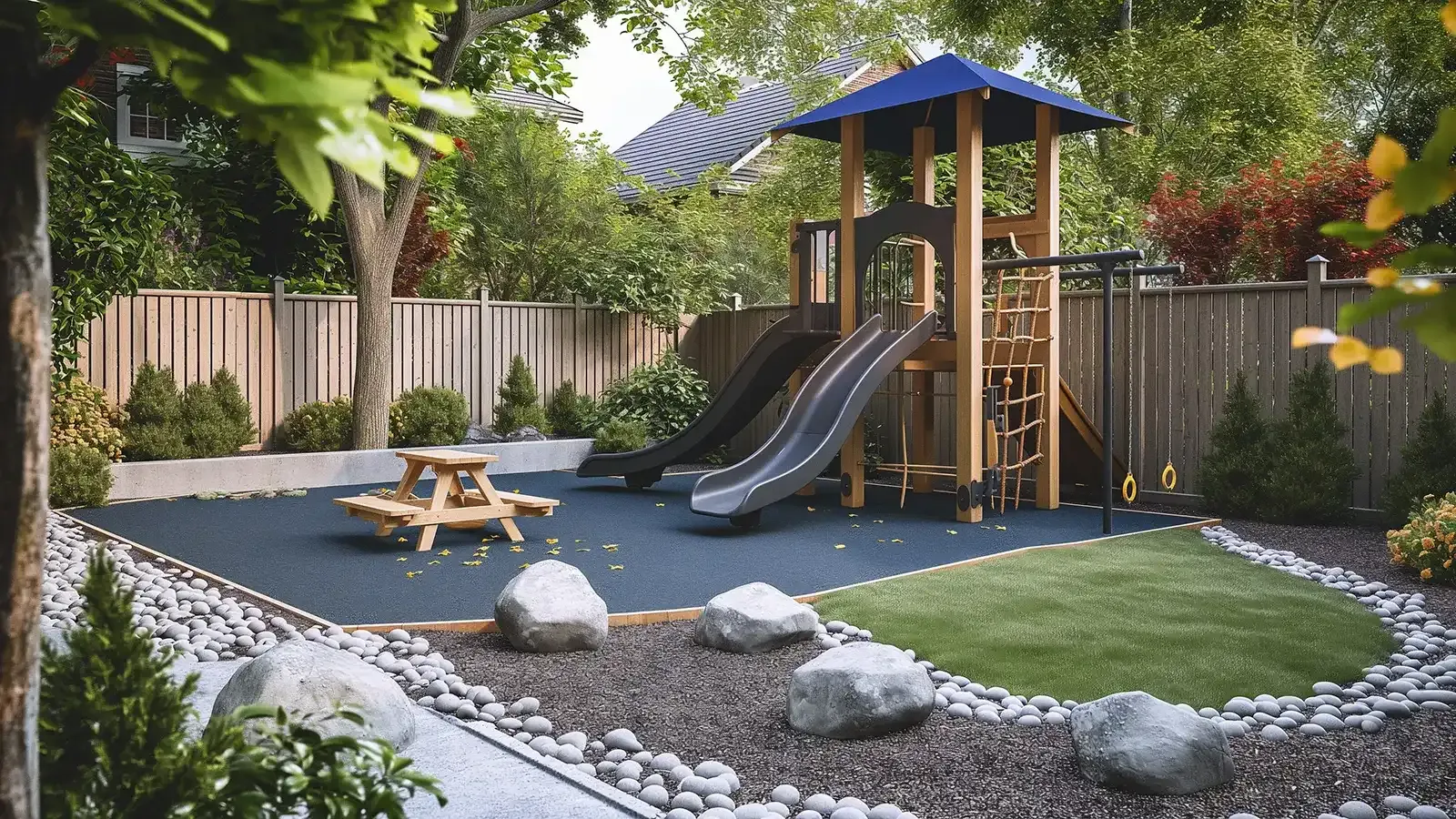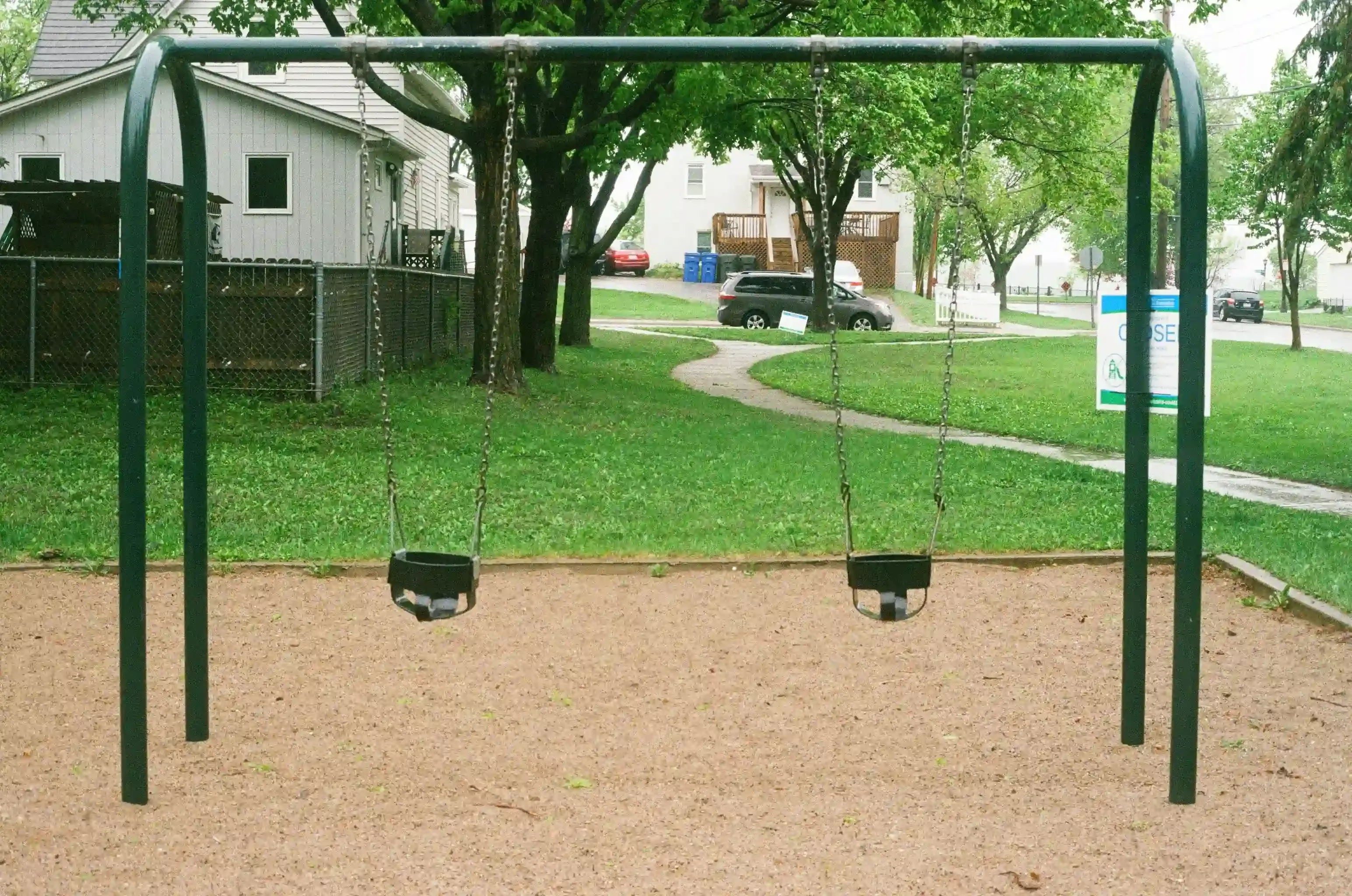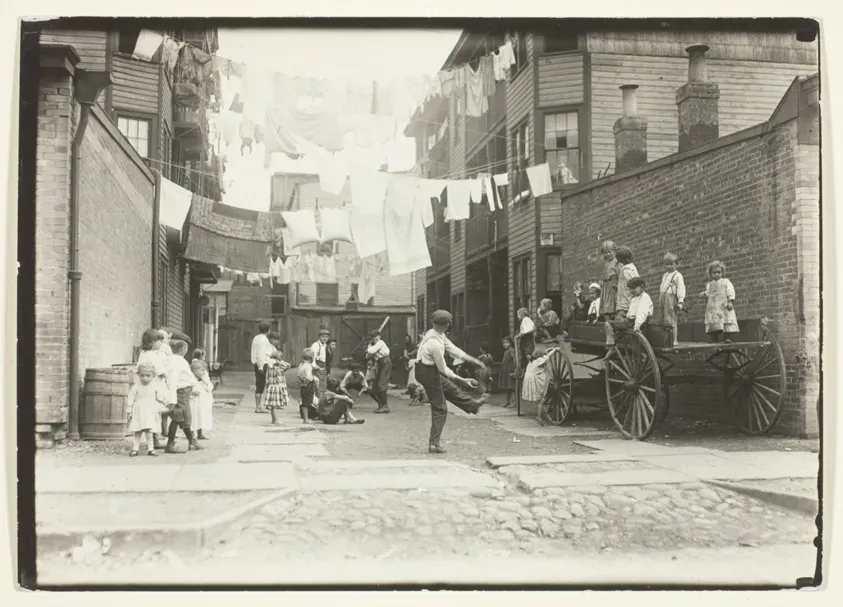Table of Contents
Thinking about setting up a swingset or a whole climbing structure in your yard? Great. Now, what are you putting *under* it? That patch of grass might look fine now, but a kid tumbling from a few feet up onto packed earth is less "fun" and more "trip to the emergency room." The truth is, the ground surface beneath the monkey bars or slide is just as crucial as the equipment itself. It's the difference between a minor bump and a serious injury. That's where exploring solid backyard playground ground ideas comes in.
Why the Right Surface Matters for Your Backyard Playground

Why the Right Surface Matters for Your Backyard Playground
It's About Avoiding Broken Bones, Frankly
Let's be real. Kids fall. A lot. They trip over their own feet, they lose their grip mid-swing, they misjudge a jump from the top of the slide. It's part of the package deal with active play. Now, picture that fall happening onto hard-packed dirt or, worse, concrete. The results aren't pretty. We're talking scrapes, sure, but also sprains, fractures, and head injuries.
The surface under your backyard playground isn't just decoration; it's the primary safety feature. It's designed to absorb impact, to cushion those inevitable tumbles and drastically reduce the severity of injuries. Choosing the right material is literally about creating a buffer zone between your child and a painful landing. Ignoring this step is like buying a car with no airbags – you hope you never need them, but if you do, you're in serious trouble.
Beyond Bumps: Maintenance, Mess, and Longevity
Safety is number one, obviously, but the ground under your backyard playground impacts more than just fall protection. Think about a rainy day. A poor surface turns into a muddy mess, tracking dirt into the house or making the area unusable for days. Weeds love bare dirt or thin grass, turning your play zone into a prickly patch.
The right material also affects how long your play area looks good and functions properly. Will it compact into concrete over time? Will it blow away in the wind? Does it attract bugs? Considering these practicalities when looking at backyard playground ground ideas saves you headaches and extra work down the line. It’s about creating a usable, clean, and sustainable play space, not just a temporary fix.
Key Considerations for Playground Ground Material:
- Impact absorption (critical for fall height)
- Drainage (prevents mud and standing water)
- Maintenance needs (weeding, topping up, cleaning)
- Durability (how well it holds up to traffic and weather)
- Cost (initial purchase and ongoing replacement)
- Accessibility (can kids with mobility issues use it?)
Comparing Popular Backyard Playground Ground Ideas

Comparing Popular Backyard Playground Ground Ideas
The Ubiquitous Wood Chips and Mulch
Walk into almost any park or look at a lot of DIY backyard playground ground ideas online, and you'll see wood chips or engineered wood fiber (EWF). It's popular for a reason: it's relatively cheap upfront and looks pretty natural. You can buy it by the truckload or the bag. The idea is that the small pieces compress slightly on impact, absorbing some of the energy from a fall. It feels softer than dirt, that's for sure.
But it's not a perfect solution. Wood chips break down over time, turning into something closer to compost. This means you have to add more regularly to maintain the right depth for safety, especially under high-traffic areas like swing paths or slide exits. They can also hide things you don't want kids stepping on, like animal waste or sharp twigs. Splinters are a definite possibility, and sometimes, if the chips are too large or not certified EWF, they don't provide the necessary impact absorption, despite appearances.
Rubber Options: Mulch, Tiles, and Poured-in-Place
Moving up the price scale, you hit rubber. This comes in a few flavors: loose rubber mulch (often made from recycled tires), interlocking rubber tiles, or poured-in-place rubber surfacing (the stuff you see in fancy municipal parks). The main selling point? Excellent impact absorption, often superior to wood products, especially at greater fall heights. Rubber mulch doesn't decompose like wood, so it requires less frequent topping up.
However, rubber mulch can get seriously hot in direct sun, potentially causing burns on little feet. It also has a distinct odor, particularly when new. Rubber tiles offer a stable, flat surface, which can be great for accessibility, but installation needs to be precise to avoid trip hazards where edges meet. Poured-in-place is the most durable and aesthetically seamless option, but it's also the most expensive by a significant margin and requires professional installation. Think long-term investment versus initial sticker shock.
Material | Initial Cost | Safety (Impact Absorption) | Maintenance | Drainage |
|---|---|---|---|---|
Wood Chips/EWF | Low | Good (if deep enough & certified) | Moderate (topping up, weeding) | Good |
Rubber Mulch | Moderate-High | Excellent | Low (less topping up) | Good |
Rubber Tiles | High | Excellent | Low (sweeping) | Variable (depends on base) |
Sand and Pea Gravel: The Classic (and Messy) Choices
Let's talk about the old school: sand and pea gravel. These are classic backyard playground ground ideas for a reason – they're relatively inexpensive and easy to dump into a designated area. They offer decent impact absorption, especially sand, provided you keep it deep enough. Kids also love playing *in* these materials, not just *on* them. Sandcastles and digging are perennial favorites.
But they have their downsides. Sand gets everywhere – in shoes, hair, clothes, and eventually, your house. It can also compact over time, losing some of its cushioning effect, and cats often mistake sandboxes for litter boxes. Pea gravel is less prone to compaction than sand but can be uncomfortable to walk or fall on. Both materials require containment to prevent them from spreading into the rest of your yard, and they can be tough for kids with mobility issues to navigate. Think about the constant sweeping and the inevitable migration of material.
Breaking Down the Best Backyard Playground Ground Ideas for Safety

Breaking Down the Best Backyard Playground Ground Ideas for Safety
Understanding Fall Height and Critical Depth
Safety isn't just about picking something soft; it's about picking something that works for the height of your play equipment. That's where "critical fall height" comes in. It's the maximum height from which a life-threatening head injury would not be expected to occur if a child falls onto the surfacing material. Every material has one, and it depends heavily on the depth of the material. A few inches of wood chips won't do much if your swing set reaches ten feet high.
Certified materials, like Engineered Wood Fiber (EWF) or specific types of rubber surfacing, come with data sheets telling you exactly what depth you need for a given fall height. This isn't guesswork; it's based on testing. When you're evaluating backyard playground ground ideas, you need to know the highest point a child could fall from on your specific equipment and then match the ground material and depth to that number. Anything less is just wishful thinking.
Why Material Quality and Installation Matter
Not all wood chips are created equal. "Playground mulch" from a random landscaping company might be full of splinters or inconsistent in size, compacting quickly into a hard surface. Certified EWF, on the other hand, is processed specifically for playground use, designed to knit together for stability but remain loose enough for impact absorption. Similarly, cheap rubber mulch might contain questionable materials or break down faster than higher-quality options.
Installation is another key piece. If you don't install proper drainage, your perfect safety surface turns into a swamp. If you don't contain loose materials like sand or gravel, they spread thin, losing their protective depth. Even rubber tiles need a level, stable base to prevent edges from lifting and becoming trip hazards. The best material in the world is useless if it's not installed correctly to maintain its safety properties over time. Skimping on the material quality or the prep work undermines the whole point of choosing a safe surface.
Common Safety Certification Standards to Look For:
- ASTM F1292 (Standard Specification for Impact Attenuation of Surfacing Materials Within the Use Zone of Playground Equipment)
- ASTM F2075 (Standard Specification for Engineered Wood Fiber for Use as Playground Surfacing)
- IPEMA Certification (Independently certified products meeting ASTM standards)
Checking for these certifications gives you a baseline assurance that the material has been tested for safety performance.
The Reality of Maintenance and Shifting Materials
Even with the right material and proper installation, ongoing maintenance is non-negotiable for safety. Loose materials like wood chips or rubber mulch will displace from under swings or at the bottom of slides due to foot traffic. This creates thin spots where falls are more dangerous. You need to regularly rake these materials back into place and plan on topping them up periodically as they decompose, blow away, or get kicked out of the area.
Think of it like filling up the gas tank; it's just part of operating the playground. Ignoring maintenance means the safety rating you paid for is no longer valid. While rubber tiles or poured surfaces require less daily upkeep, they still need regular inspection for wear and tear, seam issues, or damage. The safest backyard playground ground ideas are the ones you are committed to maintaining correctly over the long haul.
How to Install and Maintain Your Chosen Playground Ground Material

How to Install and Maintain Your Chosen Playground Ground Material
Prepping the Ground: It's Not Just Dumping Stuff
Alright, you've picked your poison – wood chips, rubber mulch, whatever fits your budget and safety needs. Now comes the actual work. Before you even think about dumping material, you gotta prep the area. This isn't optional. You need a level surface. Seriously level. Any slopes will cause loose materials to migrate, leaving thin, dangerous spots. Get out your shovel, a rake, and maybe a tamper. Remove all the grass, rocks, roots – anything that could poke through or create an uneven base. Some folks recommend a layer of landscape fabric underneath to help suppress weeds, but make sure it's permeable so water can drain. You're basically building a giant shallow box or pit for your material.
Don't forget about containment. Loose materials need an edge. Landscape timbers, plastic borders, or even just digging a slight trench around the perimeter helps keep your expensive safety surface where it belongs and not spread across the lawn like an unwelcome ground cover. This initial prep work is tedious, I know, but skipping it guarantees headaches later when you're constantly fighting migration and weeds.
Laying It Down: Depth is Your Friend
Once the area is prepped and contained, it's time to bring in the material. This is where knowing your required depth, based on your equipment's fall height, is crucial. Don't eyeball it. Use a measuring tape or mark your containment border. Dump the material and spread it evenly. For loose fills like wood chips or rubber mulch, you'll need significantly more than you think because it settles. Most safety standards require depths ranging from 6 to 12 inches, sometimes more depending on the fall height. That's a *lot* of material.
If you're using tiles or mats, the prep work is even more critical for a smooth, trip-hazard-free surface. The base needs to be perfectly level and compacted, often involving gravel or crushed stone layers. Installing these can be more labor-intensive upfront but offer a more stable, less messy surface long-term. Poured-in-place rubber is a whole other beast, requiring specialized equipment and expertise – definitely not a DIY weekend project for most people.
Essential Installation Steps:
- Clear the area of all vegetation and debris.
- Level the ground meticulously.
- Install a containment border (timbers, plastic edging).
- Consider laying permeable landscape fabric for weed control.
- Calculate the required material depth based on fall height.
- Bring in and spread the chosen material evenly.
- For tiles/mats, ensure a properly prepared, level base.
Keeping it Safe: The Never-Ending Task of Maintenance
the installation is done. Time to relax? Not exactly. Maintaining your backyard playground ground ideas is an ongoing gig. For loose fills, the main job is raking. High-traffic areas – under swings, at the bottom of slides, where kids jump off things – will see material pushed aside. You need to regularly rake it back to maintain the safety depth. Weeds will inevitably find their way through loose materials or around the edges; pull them before they take over. And plan on topping up your material every year or two, maybe more for wood products as they decompose. It's like mowing the lawn, just less frequent and usually involving a shovel.
Rubber tiles and poured surfaces require less depth maintenance but still need attention. Sweep them regularly to remove debris that could cause slips. Check seams on tiles for lifting edges. Inspect the surface for wear, tears, or damage. Proper drainage remains key; clear any blocked drains or areas where water pools. Maintenance isn't glamorous, but it’s the difference between a safe, functional play area and one that's become a potential hazard despite your initial efforts.
Considering Budget and Space for Backyard Playground Ground Ideas

Considering Budget and Space for Backyard Playground Ground Ideas
Thinking About Your Wallet and Footprint
Alright, let's get down to the nitty-gritty that often dictates everything else: how much cash are you willing to drop, and how much yard are you actually working with? These two factors are huge when you're sifting through backyard playground ground ideas. You might dream of a sprawling, seamless poured-rubber surface – the kind that looks amazing and has a safety rating through the roof – but if your budget is tight and your play area is the size of a postage stamp, that's simply not realistic. Conversely, dumping a truckload of cheap wood chips might fit the budget initially, but if you have a massive area or high-use equipment, the constant need to replace and replenish could end up costing more over time and becoming a maintenance nightmare in a large space. Size also matters for installation; a small sandbox area is easy to border and fill, while a large climbing dome needs a significant, consistently deep safety zone.
Choosing the Right Surface for Your Backyard Playground
So, you've seen the options, weighed the pros and cons, and hopefully, realized that throwing down some gravel and calling it a day isn't the move. Picking the right surface for your backyard playground ground ideas isn't the most glamorous part of building a play area, but it's arguably the most important. It’s the unsung hero preventing scraped knees from becoming broken bones. Your final decision will come down to a mix of budget, the specific equipment you have, and how much ongoing work you're willing to do. Get this part right, and you build a foundation for years of relatively safe, outdoor fun. Get it wrong, and you'll be spending more time patching up kids than enjoying watching them play.